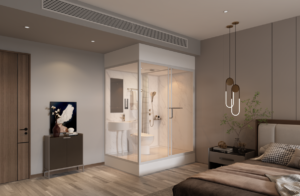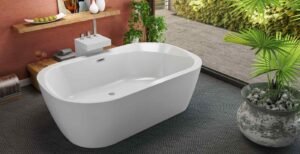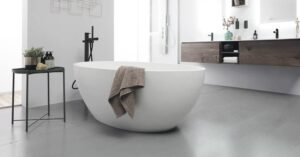You may have already seen a freestanding bath somewhere. It looks like a boat, sometimes with four feet, featured in Disney movies. You may want one now that you’re older, so I will talk more about this unique tub.
As the name suggests, freestanding tubs are single bathtubs that don’t have any of their sides attached to a wall. You may place it anywhere and even in the bathroom center to add a great accent to your space.
Since it isn’t attached to a wall, you may wonder why it needs to be freestanding? Will it move while I bathe? Can it be placed in any bathroom size? And many more. For that, I’ve prepared some things that may answer your questions.
What Makes It a Freestanding Bathtub?

The freestanding tub is one of the oldest designs of bathtubs created. It emerged in 1883 when furniture with feet, such as chairs and tables, was the thing. The newly-invented tub then adapted this method to its design, which became popular.
It is noteworthy that the popular way of bathing known by people in the said era was through bath houses, rivers, seas, and basins. Indoor plumbing was also not adequately developed during this time until the mid-1900s.
So, a freestanding tub design was the closest people could use to have a private bath.
The initial design of the bathtub was eventually modified to the apron front and contemporary tubs. The footed tubs that we see today probably look the same as the one that was first made, only with new materials and some tweaks.
As of now, bathing is more convenient, and a freestanding tub is still used. Although some of these are now preferred to be fixed on the floor.
So, how are freestanding baths secured? The following section will discuss more of these things.
What Keeps a Freestanding Tub From Moving?
Some of you may be concerned about the freestanding tub moving, so you fix the tub on the floor. The idea is alright; it’s just a matter of preference. Set tubs will ensure that hard impacts won’t move the tub, but it won’t allow you to easily carry it to another spot soon.
Weight is another factor why it’s immovable, especially when filled with water, so gravity will just do the work. But if your tub is made of lighter materials such as acrylic, then fastening it is an option.
You could also install the tub yourself if you don’t want to hire any contractors. This way, you could cut some expenses. But make sure that you have the knowledge and materials needed for the project. You could try asking some professionals for some advice.
Here is an in-depth tutorial to help you with your do-it-yourself installation:
Will It Fit in a Small Bathroom?
Some of you might think of your bathroom space as a problem when installing a freestanding tub. Before you throw the idea, start by understanding first what can be made. Start with creating a plan regarding the measurements to help you find the right tub that will fit and complement your bathroom.
First, you should identify the free spaces in your bathroom and locate the pipes, usually near the wall. Clearly, you can’t place them in the middle of your bathroom. Placing them near the wall also gives more space for other fixtures.
You can create a layout to help you visualize the spaces in your bathroom.

If possible, you can place them near the window to get some good view and natural light. You then measure how much available space is on the chosen side or corner. You must ensure that this will be a good place, especially if you plan to secure it on the floor.
Freestanding baths come in different sizes, so you may easily find one that can fit in that area. A standard size bath will have a length and width of 170 cm and 70 cm, respectively. If you need a smaller size, a compact bath has a dimension of 150 cm in length.
The tub’s material and style only come after finding the correct size. You may also get a custom-made tub to have your desired dimensions.
How Much Space Do You Need Around It?
Leaving some space between the wall structure and bathtub should also be considered when deciding its placement. It is not just for style but also for practical purposes.
The standard clearance between the sides of a freestanding tub and a wall should be about 15 cm (6 inches). This gives you enough space to clean the sides and move around your tub. It also allows less water to be splashed on your walls.
Imagine cleaning with limited space. It would be harder to reach places with dirt. You don’t want to always tilt and move your tub every cleaning day, right?
Additionally, there are back-to-wall freestanding tubs that are great for small spaces. You might want to consider this as it saves more space for your bathroom and features a contemporary design.
Suppose you are really having trouble finding the best space in your bathroom. In that case, it is better to get a consultation from contractors and plumbers.
What to Consider When Choosing a Freestanding Tub
Now that I have addressed some of the most common concerns, we will go into the detailed aspects of freestanding bathtubs. This will further help you choose the best tub suitable for you.
Freestanding bathtubs can come in every material and style. There are several to choose from, although it still depends on their availability. And needless to say, it has its fair share of pros and cons that you may want to consider.
Styles
Suppose you care deeply about your bathroom’s facade. In that case, freestanding tubs come in styles ranging from Victorian to modern designs. Aside from that, it also has types that you and your loved one can spend some time together.
- Single-Ended Tub: Has one sloped end, which is common in traditional homes. The slope is designed for comfort in the neck and back. The drain and faucet are usually located on one side.
- Double-Ended Tub: They are similar to single-ended tubs, but both ends are rounded. Made to fit two people. The faucet and drain are located in the center of the tub.
- Single Slipper Tub: One end of the tub is raised and reclined for more back comfort.
- Double Slipper Tub: Both tub ends are raised and can fit two people simultaneously, similar to a single slipper.
- Pedestal or Skirted Tub: A product of clawfoot tubs, but instead, it uses a pedestal to elevate the tub. It is suitable for large-spaced bathrooms.
- Clawfoot or Footed Tub: It has a luxurious style that initially featured a claw and ball feet. Although cleaning it may be difficult since it has more areas that need to be reached, particularly the bottom of the tub.
- Soaking Tub: Also called Japanese Soaking tub. It’s usually oval or round in shape, which is best for small spaces since it has a shorter length. They are deep enough for the water to reach your shoulders. Also comes with an integrated seat inside.
Material
If you have decided on the style you want for your bathtub, the material used is another major factor to look into. These are also used by almost all freestanding tub styles, so you have a lot to choose from!
- Acrylic: Considered the most popular and used material for almost any kind of tub. It is cheap, versatile, and lightweight. Carrying it to your upper floor bathroom won’t be a hassle.
- Cast Iron: It is a material that has been used since the first invented bathtub. They are very durable, heavy, and retain heat well.
- Artificial Stone: Made with crushed minerals and plastered with resin, they are cheaper than natural stone materials. It requires less maintenance and is also scratch-resistant.
- Copper: This material’s durability allows it to last a long time. It has a classic look that is resistant to mold and rust.
- Stainless Steel: It is less popular than the other materials. It is easy to clean and cheaper than copper.
- Stone: Natural stone material also has one of the best heat retentions among other materials. It also has an elegant appearance, although it is expensive and heavier than artificial stone.
Pros and Cons

Aside from choosing the aesthetics for your tub, it is also crucial to consider if it meets your comfort with decent functionality. Knowing the advantages and disadvantages is always necessary before purchasing a tub.
Pros
- Freestanding tubs have one of the best visuals and are often perceived as elegant, no matter the style.
- It requires fewer installation costs than inset baths. If you don’t want it to be placed in the corner of your bathroom anymore, you can just carry it to the other side of the room.
- You can choose from various styles and sizes to find something comfortable.
- It is much easier to replace for future renovations.
Cons
- You may find it difficult to clean a freestanding tub near a wall since there will be no space to reach into the sides. Deeper tubs can also be hard to clean inside if they are not fixed to the floor.
- There is no space for placing your bath products for easy reach. You may need a bath caddy for this.
- Bath styles with higher sides can be a problem for children and people who have difficulty getting in and out of a tub without grab support.
- Freestanding tubs can be expensive. The average cost goes around $1,000 to $3,000. Installation costs may be required, which is an additional expense.
These are some points to ponder before owning a freestanding bathtub. The benefits and range of styles and materials available are an asset. However, it is up to you if those are worth the disadvantages.
Conclusion
Freestanding tubs are some of the most unique tub types on the market. Interestingly, you may not fix it to the floor, which sets it apart from other tubs. It can even fit in a small-spaced bathroom with the proper design and planning.
It also displays various choices, from styles, size, and materials. However, a freestanding bath may not be for people with problems with mobility.








